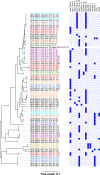Phenotypic characterization and whole genome analysis of extended-spectrum beta-lactamase-producing bacteria isolated from dogs in Germany
- PMID: 30365516
- PMCID: PMC6203360
- DOI: 10.1371/journal.pone.0206252
Phenotypic characterization and whole genome analysis of extended-spectrum beta-lactamase-producing bacteria isolated from dogs in Germany
Abstract
Asymptomatic colonization with extended-spectrum beta-lactamase (ESBL) producing Enterobacteriaceae has been described for humans, various mammal species, and birds. Here, antimicrobial resistant bacteria were recovered from dog feces originating in Germany, Kosovo, Afghanistan, Croatia, and Ukraine, with a subset of mostly E. coli isolates obtained from a longitudinal collection over twelve months. In vitro antimicrobial resistance testing revealed various patterns of resistance against single or all investigated beta-lactam antibiotics, with none of the 101 isolates resistant against two tested carbapenem antibiotics. Whole genome sequence analysis revealed bacteria species-specific patterns for 23 antimicrobial resistance coding DNA sequences (CDS) that were unapparent from the in vitro analysis alone. Phylogenetic analysis of single nucleotide polymorphisms (SNP) revealed clonal bacterial isolates originating from different dogs, suggesting transmission between dogs in the same community. However, individual resistant E. coli clones were not detected over a period longer than seven days. Multi locus sequence typing (MLST) of 85 E. coli isolates revealed 31 different sequence types (ST) with an accumulation of ST744 (n = 9), ST10 (n = 8), and ST648 (n = 6), although the world-wide hospital-associated CTX-M beta-lactamase producing ST131 was not detected. Neither the antimicrobial resistance CDSs patterns nor the phylogenetic analysis revealed an epidemiological correlation among the longitudinal isolates collected from a period longer than seven days. No genetic linkage could be associated with the geographic origin of isolates. In conclusion, healthy dogs frequently carry ESBL-producing bacteria, independent to prior treatment, which may be transmitted between individual dogs of the same community. Otherwise, these antimicrobial resistant bacteria share few commonalities, making their presence eerily unpredictable.
Conflict of interest statement
The authors have declared that no competing interests exist.
Figures

References
-
- Schmiedel J, Falgenhauer L, Domann E, Bauerfeind R, Prenger-Berninghoff E, Imirzalioglu C, et al. Multiresistant extended-spectrum beta-lactamase-producing Enterobacteriaceae from humans, companion animals and horses in central Hesse, Germany. BMC Microbiol. 2014. July 12;14:187 10.1186/1471-2180-14-187 - DOI - PMC - PubMed
-
- Sun Y, Zeng Z, Chen S, Ma J, He L, Liu Y, et al. High prevalence of bla(CTX-M) extended-spectrum beta-lactamase genes in Escherichia coli isolates from pets and emergence of CTX-M-64 in China. Clin Microbiol Infect. 2010. September;16(9):1475–81. - PubMed
Publication types
MeSH terms
Substances
LinkOut - more resources
Full Text Sources
Molecular Biology Databases

